Bike Riding Safety Tips + Gear
Share
We resonate bike safety with something we drill into children to keep them safe, but bike safety is, and always will be, for everyone. Yet, this may be something many of us forget as we get older, with our experience making us overconfident in our abilities and leaving gaps in our knowledge, increasing our chances of harm when riding.
So, whether you’re trying to teach a young loved one to be safe when riding, or need to refresh your bike riding mindset for leisure or sporting reasons, read on!
How to Be Safe Tips:
- Wear a properly fitted bike helmet
Research shows that while a helmet isn’t 100% effective in saving your life, they decrease the risk of head and brain injury up to 88%. It doesn’t matter if you’ve been riding for decades, there will always be things outside of your control, and when they do happen, you’ll be grateful you took the precaution to reduce the impact by wearing a helmet.
- Adjust your bike to fit
There is no point in using something that isn’t right for you, but riding an ill-adjusted bike only adds to your risk of injury (and not to mention, discomfort). Many of us know you can change the bike seat height easily enough, but did you know you can also easily alter other aspects, like the handle bars? You can read this to learn how to DIY your bike fit as a beginner safely.
- See and be seen
Being seen by others, especially divers, is very important in being safe on your bike, so wear bright colours and reflective clothing as much as possible. This is especially important on cloudy days, or times of day that may be darker than usual. During these times, it’s also important that you can see too, so aim to have a light on your bike, or wear a head torch when you know your vision may be reduced or obstructed. Try to avoid riding at night entirely, as this time is very dangerous because you and others can’t see well, even with torches.
- Be sun safe
When you ride your bike you’re exposed to long periods of sunlight and physical exertion. This can cause sunburn, heatstroke, or, in the long term, melanomas, which are dangerous conditions that can be easily prevented. Make sure you carry water with you at all times to stay hydrated, take breaks in the shade, and invest in a bicycle helmet brim. These products are made to keep the sun off of your face, keeping you safer when you ride. They are made for different helmet types, so make sure you have the correct one for optimum use.
- Follow the road rules
When you ride a bike on the road, you are treated as if you’re a driver of a car, so you need to take great care in following the road rules. This includes not swerving into traffic, making sure you ride on the footpath if provided, stopping before riding into a street and indicating with a hand which direction you are turning. If riding on the road, you must ride on the left side and never go against the traffic flow, and give way to pedestrians.
Note: It is suggested that until children are 10 years old, they should never ride on the road. Stick with footpaths on quiet streets and never leave them unsupervised for their own safety.

- Don’t listen to music
Keep your ears and focus free so you can be vigilant. Listening to music while riding restricts this, being potentially dangerous as you can’t hear cars or other riders and are less aware of obstructions you may face.
- Never ride under the influence of drugs or alcohol
We may think riding a bike after a few drinks is the right thing to do, and while it is better than getting behind a wheel, it still poses a serious threat to ourselves and others. As reported by the NSW Government:
“It can lower your ability to respond quickly and safely to hazards and is dangerous for you and others around you.
The safest blood alcohol concentration for any road user is zero, so it’s best to not ride if you've been drinking. If you're going out drinking, leave your bike at home. Organise a way home such as a lift with a designated driver, taxi, or public transport.”
- Wear appropriate clothing and shoes
One of the safest things you can do when riding is wear something comfortable that can’t get caught in your wheels. So leave the dresses and skirts at home and wear pants that you can move well in, and wear secure shoes that won’t fall off as you ride. Try to wear longer clothing and closed-toe shoes, because if you do have an accident, there is less chance of getting abrasions to your skin because more of it was protected.
- Keep at least one hand on the handlebars.
Both hands are preferable, but even just one hand at all times allows you to keep balance and let you break faster, should an emergency occur. For younger children, both hands should always be on the handlebars to increase their bike safety.
Safety Gear Summary:
We’ve sprinkled safety gear throughout this post, but here’s a quick list of the most necessary items we recommend. There’s always more you can do to be safer, but having these items is a great start to keeping yourself and your loved ones safe.
- Properly fitting helmet
- Reflective and/or bright clothing
- Water bottle
- Helmet brim for sun protection
- Bell
- Bike torch
If you need something more tangible for yourself, or your little bike rider, we have a downloadable graphic that you can print and use before each ride, ensuring you have the appropriate gear every time!

If you need more advice about anything bike or horse related, click this link to check out our other blogs.




